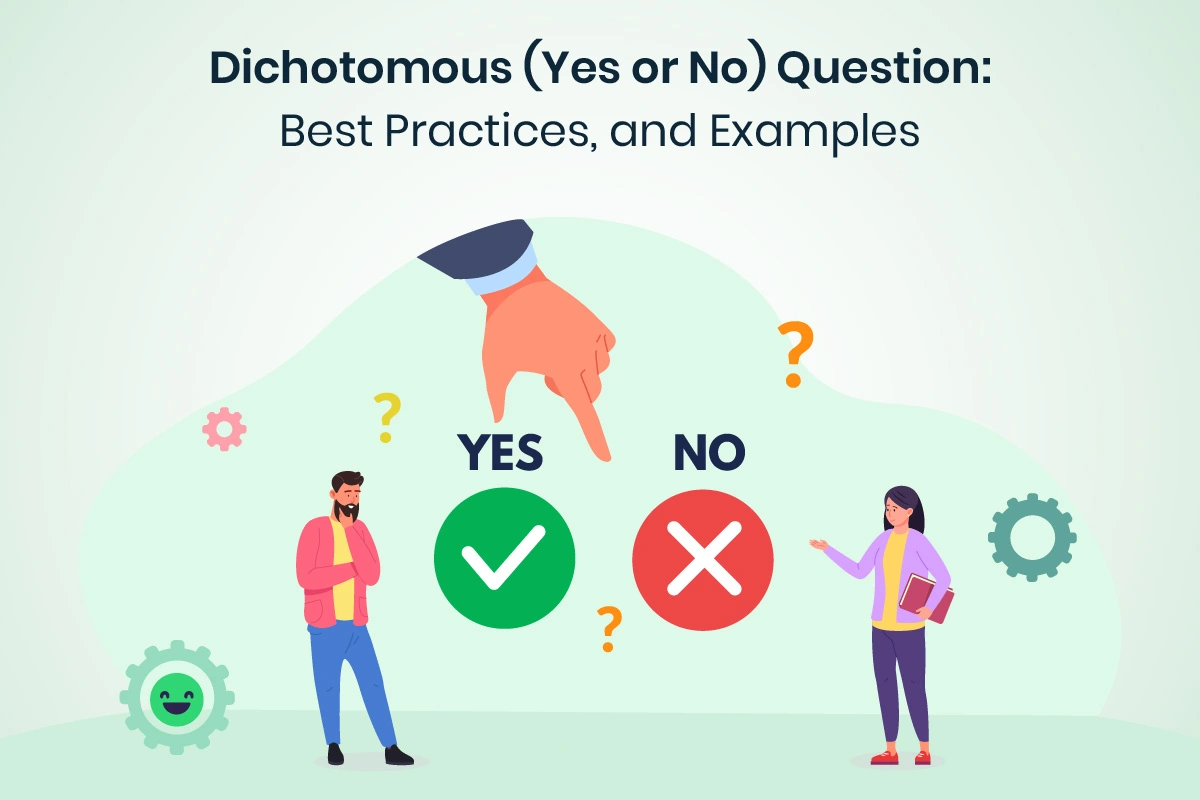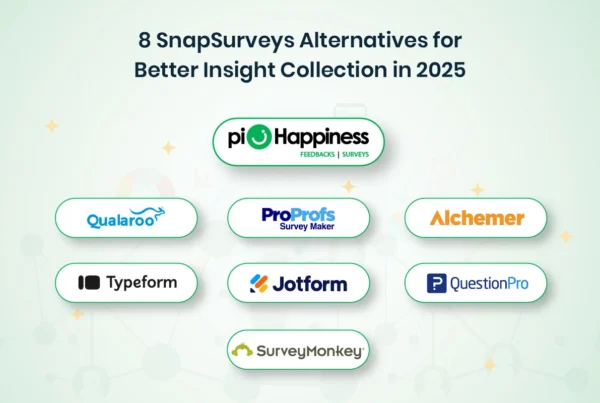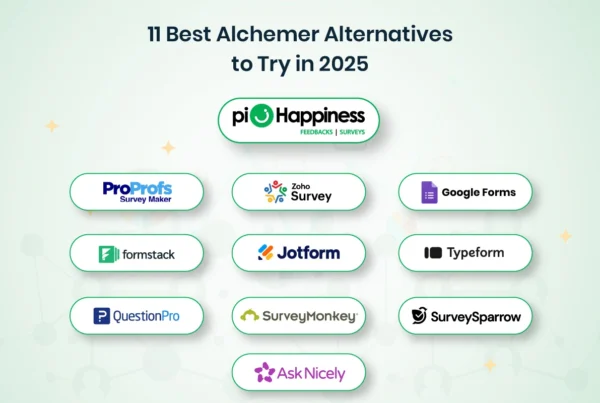In survey data collection and survey research, the simpler, the better. Some of the most fundamental types of questions used in surveys include the dichotomous questions. This question type restricts responses to as little as two responses, allowing organizations and researchers to collect data within a brief period and ascertain the outcomes with ease.
Dichotomous questions differ from open-ended questions, which often get lengthy answers. They are often used in consumer research, customer satisfaction forms, and employee engagement surveys, as they produce straightforward quantitative data and drive decision-making without overcomplicating the research design.
What is a Dichotomous Question?
A dichotomous question is a close-ended question that allows respondents to answer in only one of two possible ways. “Yes” and “No” are the most common answer pairs, but “Agree/Disagree,” “True/False,” and “Satisfied/Unsatisfied” are also frequently used.
✅ Capture instant Yes/No feedback with piHappiness!
🚀 Book your free demo today! 🎯
These question types require a subsequent question for understandings, such as fixing an issue or clarifying the reason for the answer. Hence, they are called close-ended questions. While you can technically ask a question in an open-ended form and receive a “yes” or “no” answer, it is not commonly done, nor is it advisable.
Dichotomous questions often appear in questionnaires and surveys. Because they restrict the possible answers and help to eliminate doubt and confusion ensuring that responses are easily analyzed, especially in quantitative data collection and research. It is thus a powerful category of closed-ended question types.
Dichotomous Questions vs. Closed-Ended Question Types
Though closed-ended questions involve a broad array of response formats including rating scales, multiple choice, or ranking, dichotomous questions constitute a particular subset. Every dichotomous question is closed-ended, yet not all closed-ended questions are dichotomous.
This difference is important when designing surveys. Closed-ended questions are more flexible by having several options for responses, whereas dichotomous questions are very restrictive but offer quicker and more conclusive answers. The decision between the two relies on the nature of the information you wish to obtain.
Key Advantages of Using Dichotomous Questions
The benefits are particularly valuable in certain business and research contexts.
1. Ease of Response and Higher Completion Rates: Surveys with simple yes/no questions are fast to complete. This brings down respondent fatigue and dropout rates leading to completing more surveys resulting in accumulating greater amount of data.
2. Simplified Data Analysis: This data, in turn, is categorical and nominal. That being said, it is very easy to quantify, graph, or present. You can pull percentages on the data with ease without having to use complicated statical software. This ease of interpretation makes it best for simple reporting and the creation of dashboards.
3. Eliminates Ambiguity: By excluding neutral choices, such as “Neither Agree nor Disagree” or “Maybe,” respondents are bound to choose an answer. This can be imperative when you need a true-or-false answer for a given directional decision. It brings you face to face with wherever somebody is standing on the issue: right now.
The structured nature of a yes or no survey is perfect for screening participants, gathering straightforward information, or making quick assessments before diving into more complex areas.
Limitations of Dichotomous Questions
Like with benefits dichotomous questions come with limitations as well. The binary simple question may oversimplify the issues and may fail to account for variance in participant perspectives that exist on a continuum. An example of a binary question would be “Are you happy with the product?” might fail to address the reasons why someone is dissatisfied or partly satisfied, restricting deep insights.
To cater to this need, researchers tend to pair dichotomous questions with open or scaled questions (e.g., Likert scales) to extract slightly different feedback. This blending of question types meets the need for rapid, quantifiable results yet still allows for richer, qualitative information, providing a deeper level of respondent understanding.
Best Practices for Using Dichotomous Questions
To get the most out of dichotomous questions in questionnaires, keep these best practices in mind:
- Use plain and understandable language: Ensure that no interpretation of the question can be made.
- Avoid double-edged questions: Do not pair two concepts into one question, such as “Do you find our product useful and affordable?
- Balance: When designing survey questions, balance is key. Employ dichotomous questions for screening purposes and supplement extensive items where needed.
- Limit overuse: Having too many yes/no questions in a survey can make it seem repetitive, forcing individuals to drop out of the survey.
These practices ensure closed-ended questions are impactful and actionable.
Examples of Dichotomous Survey Questions
Surveys that commonly use dichotomous questions, including the following examples:
- Are you satisfied with our product/service? (Yes/No)
- Do you currently use this product? (Yes/No)
- Would you purchase it from us again? (Yes/No)
- Did our staff resolve your issue effectively? (Yes/No)
- Do you agree with our company’s return policy? (Agree/Disagree)
The above examples demonstrate how simple wording can generate powerful insights when structured appropriately.
When to Use Dichotomous Survey Questions? (With Examples)
Dichotomous questions work best in specific scenarios. They are the perfect instrument for the task when you require qualifying, screening, or collecting binary information.
- Screening
This is among their strongest applications. You can easily screen respondents to qualify them for longer surveys or research.
Example: “Are you working currently in a managerial position? (Yes/No)”
- Determining Factual Information:
Collecting obvious, demographic, or behavioral information is an ideal use.
Example: “Do you have a smartphone? (Yes/No)”
- Measuring Agreement
They are great for checking understanding or obtaining a straightforward opinion on a clear statement.
Example: “Do you accept the above-mentioned terms and conditions? (Yes/No)”
Dichotomous Questions as Feedback Questions
In customer experience management, feedback questions play a key role in measuring satisfaction scores, loyalty metrics, company value, and user expectations. They are typically placed at the beginning of the survey as filter questions.
An apt example is the question that uses the Net Promoter System. “Did the product deliver what it promised?” Yes/No. This question would reveal satisfied and dissatisfied customer group. Following this business can ask additional questions for deeper insights and data.
Use of Dichotomous Questions in Business
Dichotomous questions serve various purposes in different industries. They are instrumental in determining whether patients in a healthcare facility were given timely attention. They are utilized in retail to check whether a purchase was made. In SaaS companies, they try to find out how much a product is used.
Dichotomous questions are universal. They can be described as essential in both short and long surveys. They work as simple assessment tools that aid in decision-making without perplexing the users.
Conclusion
Dichotomous questions have a reputation for being reductive and binary but also serve a more pragmatic purpose: collecting targeted data with maximum efficiency. Their value is in qualifying respondents, determining facts, and generating clean data sets that can be acted upon promptly.
Recognize when a dichotomous question will work and when to replace it with other types. Think about how useful a dichotomous question can be. Sometimes they are the easiest way to get to the point and retrieve the data you seek.








